Let me jump in!
To understand Torque and rpm:
Torque = Force X Radius
The above equation doesnot contain rpm so torque and rpm are not dependent directly.
Let us understand the same with another simple analogy.
Consider a Block of Wood moving on a Horizontal surface in a straight line at 1 metre/second.(Forget Friction losses, Use KISS principle!) The hand is pushing the block by say 10 N which is causing the block to move at 1 m/second.
Now if you push the block by 20 N but at the same speed ie. 1 m/sec. Will the blocks speed increase? Obviously not.
No because the hand just cannot move beyond 1 m/sec so it cannot cause the block to move beyond 1 m/sec.
Only when the hand which is pushing the block moves at say 2 m/sec then the block would move by 2 m/second.
So here comes the concept of Power to understand rpms. More power means the hand is moving now at higher speed. Here is where the time concept comes into picture.
In an engine when you press the throttle more sudden expansion of gases happen (due to a more bigger bomb exploding over the piston) which not only increase the force on the piston but also increase the rate at which force is applied on the piston.
Coming back to the Open differential.
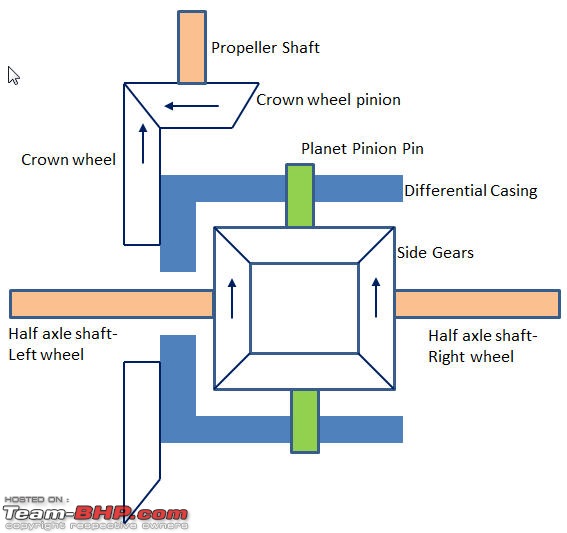
Case1 - When the vehicle is going straight.
This is how the differential will look like when going straight.
As the Crown pinion (mounted on propeller shaft) turns it rotates the Crown wheel. The Crown wheel rotates the Differential Casing in which the Planet pinions are fixed. As the casing rotates it rotates with these pins. The Planet pinions rotate with these pins not along their own axis but as a system along with the Differential Casing. There is no relative movement between planet pinion and the side gears.
Note that the Planet Pinions are not rotating along their own axis as the tooth forces on this gear are balanced equally on both sides because resistance on the two half shafts or torque on both the side gears is same.
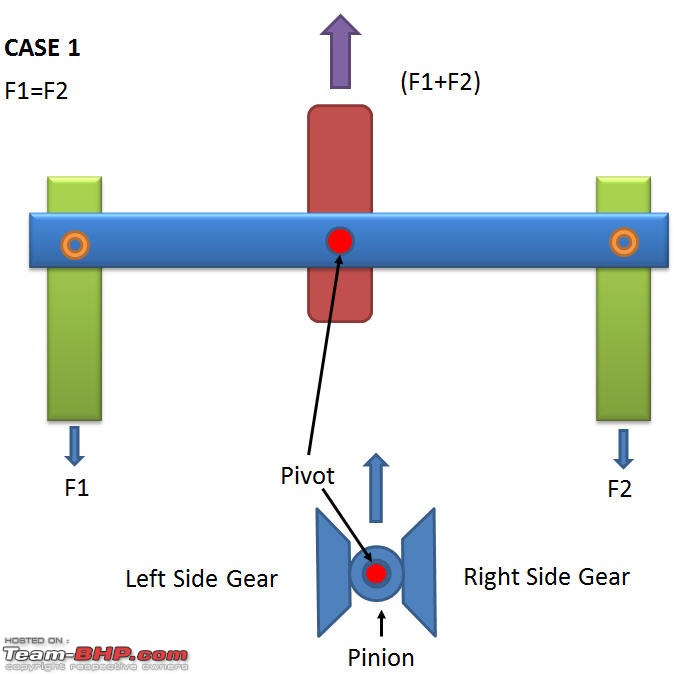
Case 1 when the vehicle is going straight or equal torque resistance on both the wheels.
I have shown the planet pinion pin as red here which was shown in green in the previous diagram.
See the bottom configuration. It represents a top view of a open differential.
Please note that I have not drawn here the crown wheel and pinion and also the Differential Casing to bring more clarity.
Now refer the upper part of diagram. The analogy represents the differential pinion (Blue link) with the red pivot representing the same pivot of the pinion.The green links represent the side gears. Consider the horizontal link as the two opposite tooth faces of the pinion gear. It can be also imagined like a weigh balance.
Both the green links are being pulled by forces F1 and F2 which are equal so the total force to be pulled by the centre link is F1+F2.
The force applied by the horizontal link to the green links is F1a(applied) and F2a.
So the whole system is balanced or in equilibrium.
Case II- The vehicle takes a right turn or the resistance on the right half shaft is higher.
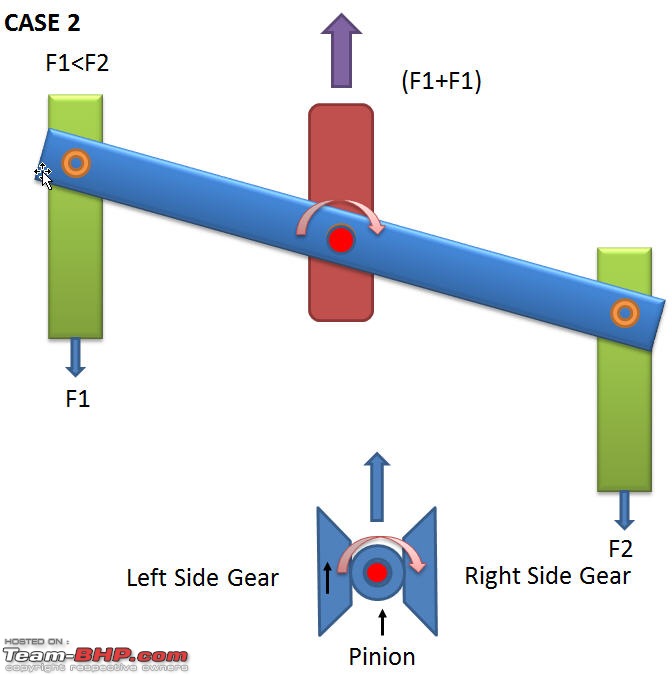
In case 2 F1<F2 which causes this imbalance. The Blue link applies forces F1a and F2a on green links respectively.
F1a=F1
Here F1a (applied) = F2a. (Being the property of the link to distribute forces equally)
But F2(external force or resistance)>F2a which causes the right green link to stay where it is and the left green link moves ahead. This causes the turning effect in the pinion. The effect is clockwise.
This clockwise movement of the pinion gear forces the left side gear to rotate further relative to the right side gear.
Note,
Here F1= F1a and F2a=F1a also F2a<F2
All the above forces you can convert them into torques by multiplying them with the respective radius of application of forces.
So if left wheel is in air, F1= minimum.
The centre link when rotating about the red pin will exert equal forces on both the sides as its the same single link throughout.
So F1a= F1
and F2a=F1a and
F2a being less than F2 will not be able to rotate the F2 wheel and the left wheel will go on spinning.
Note- If a block requires a force of 20 N to move and we apply 10N. The block will not move but that doesnot mean that we have not applied 10N force to it.
Similarly If in the above case we apply F2a(=F1a) to the right side green link. The link wont move because it is being pulled by F2 which is greater than F2a. Or that means the right wheel on hard rock will remain stationary where as the left wheel in the air will start spinning.
The more you press accelerator, the more the engine rpms will be and so the left wheel rpms will rise further.
@ Sutripta Sir I agree.
Now I am exhausted explaining the differential and its torque distribution phew!
Off topic-
I remember one stupid thing I did in my Final Engineering exams. Differential was my favourite topic because it was difficult to understand in my time when I didnt had access to internet or any physical models.I didnot had any oppurtunity to even see a real opened differential, I just had to imagine to understand it. A very harsh period for my brain indeed! The limited books available for reading used to explain the differential working mathematically. Now tell me how one can see equations at play in the actual gears rotating there? Many of the authors which I read explained differential in this dumb mathematical way of adding rpms N1+N2 and N1-N2. No book which I had read had mentioned that the planet pinion gear is free to rotate on its own axis. I used to think that the planet pinion gear is splined to its pivot pin which in turn is fixed to the differential casing without any rotation on its own axis, causing a lot of trouble for me.
In my last year of Engineering I had a elective subject of Automobile and in the Final exam I got a 8 marks question on differential.
I was so obsessed with differentials that time that I wrote 8 pages of explanation of differential its working explained in a non mathematical way and by different analogies. I spent nearly two hours writing this and I forgot that my total exam paper was of 100 marks!
Obviously I was not able to answer all the questions in time (inspite of me knowing the answers) and had to finally settle with not so good marks :(


 (3)
Thanks
(3)
Thanks


 (1)
Thanks
(1)
Thanks



 (7)
Thanks
(7)
Thanks
 (4)
Thanks
(4)
Thanks



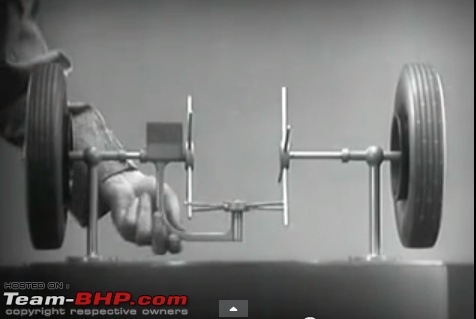
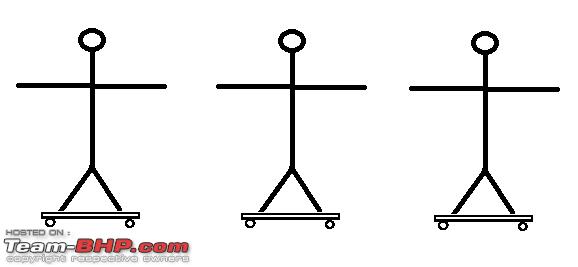

 This is still a very imperfect example, but I don't know how to improve it.
This is still a very imperfect example, but I don't know how to improve it.


